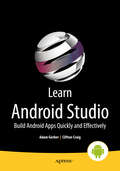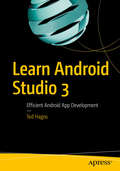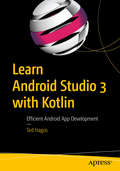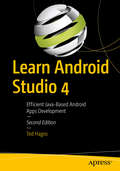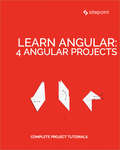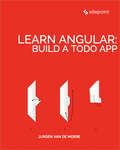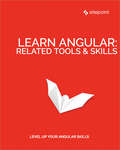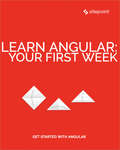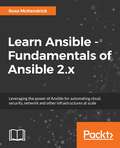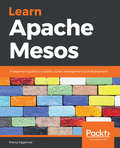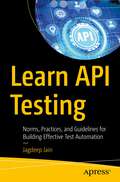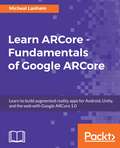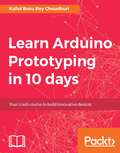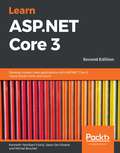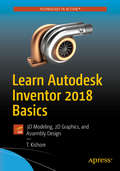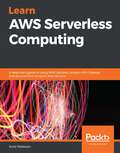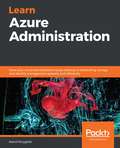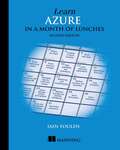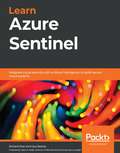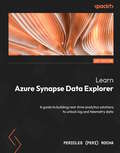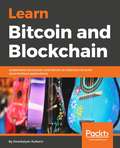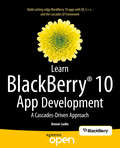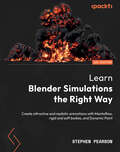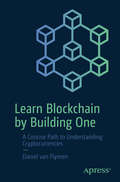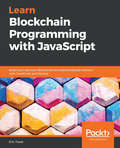- Table View
- List View
Learn Android Studio
by Adam Gerber Clifton CraigLearn Android Studio covers Android Studio and its rich tools ecosystem, including Git and Gradle: this book covers how Android Studio works seamlessly with Git, for source control, and Gradle, a build and test tool. In addition, this book demonstrates how to develop/collaborate with remote Git web-hosting services such as GitHub and Bitbucket. Four complete Android projects accompany this volume and are available for download from a public Git repository. With this book, you learn the latest and most productive tools in the Android tools ecosystem, and the best practices for Android app development. You will be able to take away the labs' code as templates or frameworks to re-use and customize for your own similar apps. Android Studio is an intuitive, feature-rich, and extremely forgiving Integrated Development Environment (IDE). This IDE is more productive and easier to use for your Android app creations than Eclipse. With this book you will quickly master Android Studio and maximize your Android development time. Source code on the remote web-hosting service is targeted to the latest Android Studio release, version 1. 2. What you'll learn How to get started with the Android Studio IDE How to navigate and use Android Studio How to do version control with Git How to use Gradle How to use the new Android Wear framework How to debug your code using Android Studio How to manage your app projects How to test your apps How to analyze and refactor your code How to customize Android Studio Who this book is for This book is for Android app developers new to this IDE tool. Table of Contents 1. Introducing Android Studio 2. Navigating 3. Programming 4. Refactoring 5. Reminders Lab: Part 1 6. Reminders Lab: Part 2 7. Git 8. Layouts 9. Currencies Lab: Part 1 10. Currencies Lab: Part 2 11. Testing and Analyzing 12. Debugging 13. Gradle 14. More SDK Tools 15. Wear 16. Customizing Android Studio
Learn Android Studio 3
by Ted HagosBuild Android apps using the popular and efficient Android Studio 3 suite of tools, an integrated development environment (IDE) for Android developers using Java APIs. With this book, you’ll learn the latest and most productive tools in the Android tools ecosystem, ensuring quick Android app development and minimal effort on your part. Along the way, you’ll use Android Studio to develop Java-based Android apps, tier by tier through practical examples. These examples cover core Android topics such as notifications and toast; intents and broadcast receivers; and services. Then, you’ll learn how to publish your apps and sell them online and in the Google Play store. What You'll LearnUse Android Studio 3 to quickly and confidently build your first Android appsBuild an Android user interface using activities and layouts, event handling, images, menus and the action barIncorporate new elements including fragmentsIntegrate data with data persistence Access the cloud Who This Book Is ForThose who may be new to Android Studio 3 or Android Studio in general. You may or may not be new to Android development in general. Some prior experience with Java is also recommended.
Learn Android Studio 3 with Kotlin: Efficient Android App Development
by Ted HagosBuild Android apps using the popular and efficient Android Studio 3 suite of tools, an integrated development environment (IDE) with which Android developers can now use the Kotlin programming language. With this book, you’ll learn the latest and most productive tools in the Android tools ecosystem, ensuring quick Android app development and minimal effort on your part. Along the way, you’ll use Android Studio to develop apps tier by tier through practical examples. These examples cover core Android topics such as Activities, Intents, BroadcastReceivers, Services and AsyncTask. Then, you’ll learn how to publish your apps and sell them online and in the Google Play store.What You’ll LearnUse Android Studio 3 to quickly and confidently build your first Android appsBuild an Android user interface using activities and layouts, event handling, images, menus and the action barIncorporate new elements including fragmentsLearn how data is persisted Use Kotlin to build appsWho This Book Is ForThose who may be new to Android Studio 3 or Android Studio in general. You may or may not be new to Android development in general. Some prior experience with Java is also recommended.
Learn Android Studio 4: Efficient Java-Based Android Apps Development
by Ted HagosBuild and deploy your Java-based Android apps using the popular and efficient Android Studio 4 suite of tools, an integrated development environment (IDE) for today's Android developers. With this book, you’ll learn the latest and most productive tools in the Android tools ecosystem, ensuring quick Android app development and minimal effort on your part. Among these tools, you'll use the new Android Studio 4 features, including an upgraded CPU profiler UI, a new build speed window, the multi-preview feature, and the live layout inspector. After reading and using this book, you'll be able to efficiently build complete Java-based Android apps that run on any Android smartphone, tablet, smart watch and more. You’ll also be able to publish those apps and sell them online and in the Google Play store. What You Will Learn Use Android Studio 4 to quickly and confidently build your first Android apps Build an Android user interface using activities and layouts, event handling, images, menus, and the action bar Work with new tools in Android Studio 4: Jetpack compose support, a smart editor for ProGuard rules, a new motion layout editor, a new Android Gradle plugin, and a fragment wizard with new fragment templates Integrate data with data persistence Access the cloud Who This Book Is For Those who may be new to Android Studio 4 or Android Studio in general. You may or may not be new to Android development. Some prior experience with Java is recommended.
Learn Angular: 4 Angular Projects
by Manjunath M Jeremy Wilken Simon Holmes Ilya Bodrov-KrukowskiAngular is not just a framework, but rather a platform that empowers developers to build applications for the web, mobile, and the desktop. This book presents a collection of complete project tutorials: building a bucket-list MEAN stack app; user authentication with MEAN; building a Twitter client with Node and Angular; and connecting Angular and the WordPress API. Along the way, you'll learn how to use Angular and some of its best features. This book is for all front-end developers who want to get proficient with Angular and its related tools. You'll need to be familiar with HTML and CSS and have a reasonable level of understanding of JavaScript in order to follow the discussion.
Learn Angular: Build a Todo App
by Jurgen van de MoereAngular is not just a framework, but rather a platform that empowers developers to build applications for the web, mobile, and the desktop. This book contains a complete tutorial on building a todo app with Angular. Along the way, we'll learn about installation and setup, component architecture, adding a REST backend, routing, authentication, and much more. This book is for all front-end developers who want to become proficient with Angular and its related tools. You'll need to be familiar with HTML and CSS and have a reasonable level of understanding of JavaScript in order to follow the discussion.
Learn Angular: Related Tool & Skills
by Jurgen van de Moere Florian Rappl Ilya Bodrov-Krukowski Jeff Smith Michael Wanyoike Todd MottoAngular is not just a framework, but rather a platform that empowers developers to build applications for the web, mobile, and the desktop. This book provides an overview of some essential Angular tools--such as Angular CLI, Angular Augary, and Sublime Text--as well as outlining some must-have TypeScript tips. This book is for all front-end developers who want to become proficient with Angular and its related tools. You'll need to be familiar with HTML and CSS and have a reasonable level of understanding of JavaScript in order to follow the discussion.
Learn Angular: Your First Week
by Ilya Bodrov-Krukowski Manjunath M Byron Houwens Jason Aden Claudio Ribeiro Kaloyan Kolev Jeremy Wilken Michael Wanyoike Vildan Softic David AdenAngular is not just a framework, but rather a platform that empowers developers to build applications for the web, mobile, and the desktop. This book contains a collection of articles that provide a rapid introduction to Angular, getting you up and running with no fuss. It contains: Angular Introduction: What It Is, and Why You Should Use It by Ilya Bodrov-KrukowskiAngularJS and Angular: a Detailed Comparison by Manjunath MAn Introduction to TypeScript: Static Typing for the Web by Byron HouwensGetting Past Hello World in Angular by Jason AdenAngular Components: Inputs and Outputs by David AdenA Practical Guide to Angular Directives by Claudio RibeiroAngular Components and Providers: Classes, Factories and Values by David AdenQuickly Create Simple Yet Powerful Angular Forms by Kaloyan KolevUsing Angular NgModules for Reusable Code and More by Jeremy WilkenAngular Testing: A Developer's Introduction by Michael WanyoikeCreating UIs with Angular Material Design Components by Ahmed BouchefraDeveloping Angular Apps without a Back End Using MockBackend by Vildan SofticReact vs Angular: An In-depth Comparison by Pavels Jelisejevs This book is for all front-end developers who want to get proficient with Angular and its related tools. You'll need to be familiar with HTML and CSS and have a reasonable level of understanding of JavaScript in order to follow the discussion.
Learn Ansible: Automate cloud, security, and network infrastructure using Ansible 2.x
by Russ McKendrickRun Ansible playbooks to launch complex multi-tier applications hosted in public cloudsKey FeaturesBuild your learning curve using AnsibleAutomate cloud, network, and security infrastructures with easeGain hands-on exposure on AnsibleBook DescriptionAnsible has grown from a small, open source orchestration tool to a full-blown orchestration and configuration management tool owned by Red Hat. Its powerful core modules cover a wide range of infrastructures, including on-premises systems and public clouds, operating systems, devices, and services—meaning it can be used to manage pretty much your entire end-to-end environment. Trends and surveys say that Ansible is the first choice of tool among system administrators as it is so easy to use.This end-to-end, practical guide will take you on a learning curve from beginner to pro. You'll start by installing and configuring the Ansible to perform various automation tasks. Then, we'll dive deep into the various facets of infrastructure, such as cloud, compute and network infrastructure along with security.By the end of this book, you'll have an end-to-end understanding of Ansible and how you can apply it to your own environments.What you will learnWrite your own playbooks to configure servers running CentOS, Ubuntu, and WindowsIdentify repeatable tasks and write playbooks to automate themDefine a highly available public cloud infrastructure in code, making it easy to distribute your infrastructure configurationDeploy and configure Ansible Tower and Ansible AWXLearn to use community contributed rolesUse Ansible in your day-to-day role and projectsWho this book is forLearn Ansible is perfect for system administrators and developers who want to take their current workflows and transform them into repeatable playbooks using Ansible. No prior knowledge of Ansible is required.
Learn Apache Mesos: A beginner’s guide to scalable cluster management and deployment
by Manuj AggarwalScale applications with high availability and optimized resource management across data centersKey FeaturesCreate clusters and perform scheduling, logging, and resource administration with MesosExplore practical examples of managing complex clusters at scale with real-world dataWrite native Mesos frameworks with PythonBook DescriptionApache Mesos is an open source cluster manager that provides efficient resource isolation and sharing across distributed applications or frameworks. This book will help you build a strong foundation of Mesos' capabilities along with practical examples to support the concepts explained throughout the book.Learn Apache Mesos dives straight into how Mesos works. You will be introduced to the distributed system and its challenges and then learn how you can use Mesos and its framework to solve data problems. You will also gain a full understanding of Mesos' internal mechanisms and get equipped to use Mesos and develop applications. Furthermore, this book lets you explore all the steps required to create highly available clusters and build your own Mesos frameworks. You will also cover application deployment and monitoring.By the end of this book, you will have learned how to use Mesos to make full use of machines and how to simplify data center maintenance.What you will learnDeploy and monitor a Mesos clusterSet up servers on AWS to deploy Mesos componentsExplore Mesos resource scheduling and the allocation moduleDeploy Docker-based services and applications using Mesos MarathonConfigure and use SSL to protect crucial endpoints of your Mesos clusterDebug and troubleshoot services and workloads on a Mesos clusterWho this book is forThis book is for DevOps and data engineers and administrators who work with large data clusters. You’ll also find this book useful if you have experience working with virtualization, databases, and platforms such as Hadoop and Spark. Some experience in database administration and design will help you get the most out of this book.
Learn API Testing: Norms, Practices, and Guidelines for Building Effective Test Automation
by Jagdeep JainExplore software web application architecture, API testing, coding practices, and the standards for better API test automation development and management. This book focuses on aspiring software testing engineers currently working in API testing, and those starting their journey in the field of software testing. You’ll begin with an introduction to API testing and software web applications involving APIs. The book then moves on to the authentication standards used in the software industry, and the tools, the frameworks, and the libraries used in API testing. As the book progresses, you’ll learn about the test pyramid, how to test an API, what makes a good test script, and various coding guidelines. Finally, you get to write your own API test script. Learn API Testing is your pathway to understanding a typical software web application, its requests and responses, and the properties of a good test script. What You’ll learnExamine practices, standards, and guidelines for effective test automationWork with different tools like RestAssured, Curl, and PostmanUnderstand API testing paradigm (internal/external APIs, CDCT)Review a case study on the industrial software API testing processOrganize a test frameworkWho This Book Is For API testing aspirants, developers/architects, project managers, and non-technical team members who may want to understand how APIs are being tested.
Learn ARCore - Fundamentals of Google ARCore: Learn to build augmented reality apps for Android, Unity, and the web with Google ARCore 1.0
by Micheal LanhamCreate next-generation Augmented Reality and Mixed Reality apps with the latest version of Google ARCoreKey FeaturesHarness the power of the Google’s new augmented reality (AR) platform ARCore to build cutting-edge Augmented reality appsLearn core concepts of Environmental Understanding, Immersive Computing, and Motion Tracking with ARCoreExtend your application by combining ARCore with OpenGL, Machine Learning and more.Book DescriptionAre you a mobile developer or web developer who wants to create immersive and cool Augmented Reality apps with the latest Google ARCore platform? If so, this book will help you jump right into developing with ARCore and will help you create a step by step AR app easily. This book will teach you how to implement the core features of ARCore starting from the fundamentals of 3D rendering to more advanced concepts such as lighting, shaders, Machine Learning, and others. We’ll begin with the basics of building a project on three platforms: web, Android, and Unity. Next, we’ll go through the ARCore concepts of motion tracking, environmental understanding, and light estimation. For each core concept, you’ll work on a practical project to use and extend the ARCore feature, from learning the basics of 3D rendering and lighting to exploring more advanced concepts. You’ll write custom shaders to light virtual objects in AR, then build a neural network to recognize the environment and explore even grander applications by using ARCore in mixed reality. At the end of the book, you’ll see how to implement motion tracking and environment learning, create animations and sounds, generate virtual characters, and simulate them on your screen.What you will learn Build and deploy your Augmented Reality app to the Android, Web, and Unity platforms Implement ARCore to identify and visualize objects as point clouds, planes, surfaces, and/or meshes Explore advanced concepts of environmental understanding using Google ARCore and OpenGL ES with Java Create light levels from ARCore and create a C# script to watch and propagate lighting changes in a scene Develop graphics shaders that react to changes in lighting and map the environment to place objects in Unity/C# Integrate motion tracking with the Web ARCore API and Google Street View to create a combined AR/VR experienceWho this book is forThis book is for web and mobile developers who have broad programming knowledge on Java or JavaScript or C# and want to develop Augmented Reality applications with Google ArCore. To follow this book no prior experience with AR development, 3D, or 3D math experience is needed.
Learn Arduino Prototyping in 10 days
by Kallol Bosu ChoudhuriThe ultimate power-packed crash course in building Arduino-based projects in just 10 days! About This Book • A carefully designed 10-day crash course, covering major project/device types, with 20+ unique hands-on examples • Get easy-to-understand explanations of basic electronics fundamentals and commonly used C sketch functions • This step-by-step guide with 90+ diagrams and 50+ important tips will help you become completely self-reliant and confident Who This Book Is For This book is a beginner's crash course for professionals, hobbyists, and students who are tech savvy, have a basic level of C programming knowledge, and basic familiarity with electronics, be it for embedded systems or the Internet of Things. What You Will Learn • Write Arduino sketches and understand the fundamentals of building prototype circuits using basic electronic components, such as resistors, transistors, and diodes • Build simple, compound, and standalone devices with auxiliary storage (SD card), a DC battery, and AC power supplies • Deal with basic sensors and interface sensor modules by using sensor datasheets • Discover the fundamental techniques of prototyping with actuators • Build remote-controlled devices with infrared (IR), radio frequency (RF), and telephony with GSM • Learn IoT edge device prototyping (using ESP8266) and IoT cloud configuration In Detail This book is a quick, 10-day crash course that will help you become well acquainted with the Arduino platform. The primary focus is to empower you to use the Arduino platform by applying basic fundamental principles. You will be able to apply these principles to build almost any type of physical device. The projects you will work through in this book are self-contained micro-controller projects, interfacing with single peripheral devices (such as sensors), building compound devices (multiple devices in a single setup), prototyping standalone devices (powered from independent power sources), working with actuators (such as DC motors), interfacing with an AC-powered device, wireless devices (with Infrared, Radio Frequency and GSM techniques), and finally implementing the Internet of Things (using the ESP8266 series Wi-Fi chip with an IoT cloud platform). The first half of the book focuses on fundamental techniques and building basic types of device, and the final few chapters will show you how to prototype wireless devices. By the end of this book, you will have become acquainted with the fundamental principles in a pragmatic and scientific manner. You will also be confident enough to take up new device prototyping challenges. Style and approach This step-by- step guide will serve as a quick, 10-day crash course to help you become well acquainted with the Arduino platform.
Learn ASP.NET Core 3: Develop modern web applications with ASP.NET Core 3, Visual Studio 2019, and Azure, 2nd Edition
by Kenneth Yamikani Fukizi Jason De Oliveira Michel BruchetA beginner's guide to building fully functioning web applications from scratch using the latest features of ASP.NET Core 3 and C# 8 Key Features Get to grips with the new features and APIs in ASP.NET Core 3, EF Core 3, and Blazor Create web APIs that integrate your applications with other systems and services Learn to deploy your web applications in new environments such as the cloud and Docker containers Book Description ASP.NET Core is an open source framework from Microsoft that makes it easy to build highly efficient and dynamic cross-platform web applications. Updated for the latest features of ASP.NET Core 3, this second edition will equip you with the skills you need to build powerful web applications. The book starts with an introduction to ASP.NET Core and its features, giving you a complete understanding of the framework. You will also learn how to set up your development environment with Visual Studio 2019 and build a fully functioning application from scratch. You'll then understand core concepts for building web applications such as Model View Controller (MVC), dependency injection, and WebSockets. As you advance, you'll discover how to use Entity Framework Core 3 to automate all database-related activities for your application. You will then build and document secure web APIs using security best practices to protect your web applications from threats and vulnerabilities. Finally, you will learn how to use Azure DevOps as a CI/CD tool to deploy and monitor your applications using Microsoft Azure, Amazon Web Services (AWS), and Docker. By the end of this book, you'll have the skills you need to develop efficient and robust web applications in ASP.NET Core 3. What you will learn Delve into basic and advanced ASP.NET Core 3 concepts with the help of examples Build an MVC web application and use Entity Framework Core 3 to access data Add web APIs to your web applications using RPC, REST, and HATEOAS Create a fully automated continuous integration and continuous delivery (CI/CD) pipeline using Azure DevOps Use Azure, Amazon Web Services, and Docker to deploy and monitor your applications Secure your web application from common attacks such as Cross-Site Scripting and SQL injection Explore client-side development using C# Razor components Who this book is for This book is for developers who want to build modern web applications with ASP.NET Core. The book will also be helpful for anyone working in infrastructure engineering and operations to monitor and diagnose problems during the runtime of ASP.NET Core 3.0 web applications. Although no prior understanding of ASP.NET or .NET Core is required, basic C# programming knowledge is assumed.
Learn Autodesk Inventor 2018 Basics: 3D Modeling, 2D Graphics, and Assembly Design
by T. KishoreGet started with the basics of part modeling, assembly modeling, presentations, and drawings in this step-by-step tutorial on Autodesk Inventor fundamentals. Next, this book teaches you some intermediate-level topics such as additional part modeling tools, sheet metal modeling, top-down assembly features, assembly joints, and dimension and annotations. Engaging explanations, practical examples, and step-by-step instructions make this tutorial book complete. Once you have read Learn Autodesk Inventor 2018 Basics you will be able to use Autodesk Inventor for 3D modeling, 2D drawings, finite element analysis, mold design, and other purposes, just like a design professional. You will gain all the basic information and essential skills you need to work in Autodesk Inventor immediately. What You'll Learn Carry out virtual 3D modeling for your next 3D printing projects Design molds for 3D printing and other projects Generate 2D drawings Who This Book Is For Novice users of Autodesk Inventor.
Learn AWS Serverless Computing: A beginner's guide to using AWS Lambda, Amazon API Gateway, and services from Amazon Web Services
by Scott PattersonBuild, deploy, test, and run cloud-native serverless applications using AWS Lambda and other popular AWS services Key Features Learn how to write, run, and deploy serverless applications in Amazon Web Services Make the most of AWS Lambda functions to build scalable and cost-efficient systems Build and deploy serverless applications with Amazon API Gateway and AWS Lambda functions Book Description Serverless computing is a way to run your code without having to provision or manage servers. Amazon Web Services provides serverless services that you can use to build and deploy cloud-native applications. Starting with the basics of AWS Lambda, this book takes you through combining Lambda with other services from AWS, such as Amazon API Gateway, Amazon DynamoDB, and Amazon Step Functions. You'll learn how to write, run, and test Lambda functions using examples in Node.js, Java, Python, and C# before you move on to developing and deploying serverless APIs efficiently using the Serverless Framework. In the concluding chapters, you'll discover tips and best practices for leveraging Serverless Framework to increase your development productivity. By the end of this book, you'll have become well-versed in building, securing, and running serverless applications using Amazon API Gateway and AWS Lambda without having to manage any servers. What you will learn Understand the core concepts of serverless computing in AWS Create your own AWS Lambda functions and build serverless APIs using Amazon API Gateway Explore best practices for developing serverless applications at scale using Serverless Framework Discover the DevOps patterns in a modern CI/CD pipeline with AWS CodePipeline Build serverless data processing jobs to extract, transform, and load data Enforce resource tagging policies with continuous compliance and AWS Config Create chatbots with natural language understanding to perform automated tasks Who this book is for This AWS book is for cloud architects and developers who want to build and deploy serverless applications using AWS Lambda. A basic understanding of AWS is required to get the most out of this book.
Learn Azure Administration: Solve your cloud administration issues relating to networking, storage, and identity management speedily and efficiently
by Kamil MrzyglodEnhance your Azure administration and Azure DevOps skills and get up and running with networking, security, automation, and effective cost managementKey FeaturesExplore a variety of administration patterns used for different cloud architecturesDiscover best practices for administering various IT systems hosted in AzureAdminister, automate, and manage your Azure cloud environment effectivelyBook DescriptionMicrosoft Azure is one of the upcoming cloud platforms that provide cost-effective solutions and services to help businesses overcome complex infrastructure-related challenges. This book will help you scale your cloud administration skills with Microsoft Azure.Learn Azure Administration starts with an introduction to the management of Azure subscriptions, and then takes you through Azure resource management. Next, you'll configure and manage virtual networks and find out how to integrate them with a set of Azure services. You'll then handle the identity and security for users with the help of Azure Active Directory, and manage access from a single place using policies and defined roles. As you advance, you'll get to grips with receipts to manage a virtual machine. The next set of chapters will teach you how to solve advanced problems such as DDoS protection, load balancing, and networking for containers. You'll also learn how to set up file servers, along with managing and storing backups. Later, you'll review monitoring solutions and backup plans for a host of services. The last set of chapters will help you to integrate different services with Azure Event Grid, Azure Automation, and Azure Logic Apps, and teach you how to manage Azure DevOps.By the end of this Azure book, you'll be proficient enough to easily administer your Azure-based cloud environment.What you will learnExplore different Azure services and understand the correlation between themSecure and integrate different Azure componentsWork with a variety of identity and access management (IAM) modelsFind out how to set up monitoring and logging solutionsBuild a complete skill set of Azure administration activities with Azure DevOpsDiscover efficient scaling patterns for small and large workloadsWho this book is forThis book is for cloud administrators, system administrators, and IT professionals who want to scale up their skillset and enter the world of cloud computing. IT professionals and engineers who are already familiar with the basics of the Azure services and are looking for a step-by-step guide to solving the most common Azure problems will also find this book useful. Basic understanding of cloud concepts such as IaaS, PaaS, virtualization, networking, and common Azure services is required.
Learn Azure in a Month of Lunches
by Iain FouldsLearn Azure in a Month of Lunches, Second Edition, is a tutorial on writing, deploying, and running applications in Azure. In it, you&’ll work through 21 short lessons that give you real-world experience. Each lesson includes a hands-on lab so you can try out and lock in your new skills.Summary You can be incredibly productive with Azure without mastering every feature, function, and service. Learn Azure in a Month of Lunches, Second Edition gets you up and running quickly, teaching you the most important concepts and tasks in 21 practical bite-sized lessons. As you explore the examples, exercises, and labs, you'll pick up valuable skills immediately and take your first steps to Azure mastery! This fully revised new edition covers core changes to the Azure UI, new Azure features, Azure containers, and the upgraded Azure Kubernetes Service. Purchase of the print book includes a free eBook in PDF, Kindle, and ePub formats from Manning Publications. About the technology Microsoft Azure is vast and powerful, offering virtual servers, application templates, and prebuilt services for everything from data storage to AI. To navigate it all, you need a trustworthy guide. In this book, Microsoft engineer and Azure trainer Iain Foulds focuses on core skills for creating cloud-based applications. About the book Learn Azure in a Month of Lunches, Second Edition, is a tutorial on writing, deploying, and running applications in Azure. In it, you&’ll work through 21 short lessons that give you real-world experience. Each lesson includes a hands-on lab so you can try out and lock in your new skills. What's inside Understanding Azure beyond point-and-click Securing applications and data Automating your environment Azure services for machine learning, containers, and more About the reader This book is for readers who can write and deploy simple web or client/server applications. About the author Iain Foulds is an engineer and senior content developer with Microsoft. Table of Contents PART 1 - AZURE CORE SERVICES 1 Before you begin 2 Creating a virtual machine 3 Azure Web Apps 4 Introduction to Azure Storage 5 Azure Networking basics PART 2 - HIGH AVAILABILITY AND SCALE 6 Azure Resource Manager 7 High availability and redundancy 8 Load-balancing applications 9 Applications that scale 10 Global databases with Cosmos DB 11 Managing network traffic and routing 12 Monitoring and troubleshooting PART 3 - SECURE BY DEFAULT 13 Backup, recovery, and replication 14 Data encryption 15 Securing information with Azure Key Vault 16 Azure Security Center and updates PART 4 - THE COOL STUFF 17 Machine learning and artificial intelligence 18 Azure Automation 19 Azure containers 20 Azure and the Internet of Things 21 Serverless computing
Learn Azure Sentinel: Integrate Azure security with artificial intelligence to build secure cloud systems
by Richard Diver Gary Bushey Jason S. RaderUnderstand how to set up, configure, and use Azure Sentinel to provide security incident and event management services for your environment Key Features Secure your network, infrastructure, data, and applications on Microsoft Azure effectively Integrate artificial intelligence, threat analysis, and automation for optimal security solutions Investigate possible security breaches and gather forensic evidence to prevent modern cyber threats Book Description Azure Sentinel is a Security Information and Event Management (SIEM) tool developed by Microsoft to integrate cloud security and artificial intelligence (AI). Azure Sentinel not only helps clients identify security issues in their environment, but also uses automation to help resolve these issues. With this book, you'll implement Azure Sentinel and understand how it can help find security incidents in your environment with integrated artificial intelligence, threat analysis, and built-in and community-driven logic. This book starts with an introduction to Azure Sentinel and Log Analytics. You'll get to grips with data collection and management, before learning how to create effective Azure Sentinel queries to detect anomalous behaviors and patterns of activity. As you make progress, you'll understand how to develop solutions that automate the responses required to handle security incidents. Finally, you'll grasp the latest developments in security, discover techniques to enhance your cloud security architecture, and explore how you can contribute to the security community. By the end of this book, you'll have learned how to implement Azure Sentinel to fit your needs and be able to protect your environment from cyber threats and other security issues. What you will learn Understand how to design and build a security operations center Discover the key components of a cloud security architecture Manage and investigate Azure Sentinel incidents Use playbooks to automate incident responses Understand how to set up Azure Monitor Log Analytics and Azure Sentinel Ingest data into Azure Sentinel from the cloud and on-premises devices Perform threat hunting in Azure Sentinel Who this book is for This book is for solution architects and system administrators who are responsible for implementing new solutions in their infrastructure. Security analysts who need to monitor and provide immediate security solutions or threat hunters looking to learn how to use Azure Sentinel to investigate possible security breaches and gather forensic evidence will also benefit from this book. Prior experience with cloud security, particularly Azure, is necessary.
Learn Azure Synapse Data Explorer: A guide to building real-time analytics solutions to unlock log and telemetry data
by Pericles (Peri) RochaA hands-on guide to working on use cases helping you ingest, analyze, and serve insightful data from IoT as well as telemetry data sources using Azure Synapse Data ExplorerFree PDF included with this bookKey FeaturesAugment advanced analytics projects with your IoT and application dataExpand your existing Azure Synapse environments with unstructured dataBuild industry-level projects on integration, experimentation, and dashboarding with Azure SynapseBook DescriptionLarge volumes of data are generated daily from applications, websites, IoT devices, and other free-text, semi-structured data sources. Azure Synapse Data Explorer helps you collect, store, and analyze such data, and work with other analytical engines, such as Apache Spark, to develop advanced data science projects and maximize the value you extract from data.This book offers a comprehensive view of Azure Synapse Data Explorer, exploring not only the core scenarios of Data Explorer but also how it integrates within Azure Synapse. From data ingestion to data visualization and advanced analytics, you'll learn to take an end-to-end approach to maximize the value of unstructured data and drive powerful insights using data science capabilities. With real-world usage scenarios, you'll discover how to identify key projects where Azure Synapse Data Explorer can help you achieve your business goals. Throughout the chapters, you'll also find out how to manage big data as part of a software as a service (SaaS) platform, as well as tune, secure, and serve data to end users.By the end of this book, you'll have mastered the big data life cycle and you'll be able to implement advanced analytical scenarios from raw telemetry and log data.What you will learnIntegrate Data Explorer pools with all other Azure Synapse servicesCreate Data Explorer pools with Azure Synapse Studio and Azure PortalIngest, analyze, and serve data to users using Azure Synapse pipelinesIntegrate Power BI and visualize data with Synapse StudioConfigure Azure Machine Learning integration in Azure SynapseManage cost and troubleshoot Data Explorer pools in Synapse AnalyticsSecure Synapse workspaces and grant access to Data Explorer poolsWho this book is forIf you are a data engineer, data analyst, or business analyst working with unstructured data and looking to learn how to maximize the value of such data, this book is for you. If you already have experience working with Azure Synapse and want to incorporate unstructured data into your data science project, you'll also find plenty of useful information in this book. To maximize your learning experience, familiarity with data and performing simple queries using SQL or KQL is recommended. Basic knowledge of Python will help you get more from the examples.
Learn Bitcoin and Blockchain: Understanding blockchain and Bitcoin architecture to build decentralized applications
by Kirankalyan KulkarniGet up and running with the fundamentals of Bitcoin and blockchainKey FeaturesLearn quick, effective, and easy ways to master blockchain and Bitcoin Understand the impact of decentralization and discover ways to tackle it Explore the future of Bitcoin and blockchain and implement them in a business networkBook DescriptionBlockchain is a distributed database that enables permanent, transparent, and secure storage of data. Blockchain technology uses cryptography to keep data secure. Learn Bitcoin and Blockchain is the perfect entry point to the world of decentralized databases.This book will take you on a journey through the blockchain database, followed by advanced implementations of the blockchain concept. You will learn about Bitcoin basics and their technical operations. As you make your way through the book, you will gain insight into this leading technology and its implementation in the real world. You will also cover the technical foundation of blockchain and understand the fundamentals of cryptography and how they keep data secure. In the concluding chapters, you’ll get to grips with the mechanisms behind cryptocurrencies.By the end of this book, you will have learned about decentralized digital money, advanced blockchain concepts, and Bitcoin and blockchain security.What you will learnUnderstand the concept of decentralization, its impact, its relationship with blockchain technology and its pros and consLearn blockchain and Bitcoin architectures and securityExplore Bitcoin and blockchain securityImplement blockchain technology and its features commerciallyUnderstand why consensus protocols are critical in blockchainGet a grip on the future of blockchainWho this book is forLearn Bitcoin and Blockchain is for anyone who wants to quickly understand and expand their knowledge of how blockchain and Bitcoin work and how they are applied commercially. No prior knowledge of blockchain and Bitcoin is required.
Learn BlackBerry 10 App Development: A Cascades-Driven Approach
by Anwar LudinLearn how to leverage the BlackBerry 10 Cascades framework to create rich native applications. Learn BlackBerry 10 App Development gives you a solid foundation for creating BlackBerry 10 apps efficiently. Along the way, you will learn how to use QML and JavaScript for designing your app's UI, and C++/Qt for the application logic. No prior knowledge of C++ is assumed and the book covers the fundamental aspects of the language for writing BlackBerry 10 apps. Also a particular emphasis is put on how to create a visually enticing user experience with the Cascades framework, which is based on Qt and QML. Starting with the native SDK configuration and an overview of the Momentics IDE, the book is fast-paced and you will rapidly learn many of the best practices and techniques required for developing beautiful BlackBerry 10 apps. Learn BlackBerry 10 App Development is written for developers wishing to learn how to write apps for the new BlackBerry 10 OS and those interested in porting existing iOS and Android apps to BlackBerry 10 as native applications. What you'll learn * How to design and create native BB10 applications using the declarative expressiveness of QML * How to master the Cascades framework and the core BB10 UI components * How to use C++ and Qt efficiently with Cascades * How to utilize the BlackBerry Momentics IDE to launch and debug your applications * How to apply the fundamental aspects and best practices of BB10 application design * How to use HTTP networking in order to leverage remote services * How to integrate your application with BlackBerry 10 core apps such as the Contacts and Calendar apps * How to send email and short text messages from your app * How to use your device's camera and sensors such as the accelerometer and gyroscope Who this book is for BlackBerry developers wishing to write native BB10 applications, game developers. iOS and Android developers wishing to port their apps to BB 10. Table of Contents Getting Started QML & JavaScript C++, Qt and Cascades Controls Application Structure ListView and DataModel HTTP Networking Personal Information Management APIs Sensors Invocation Framework Device File System
Learn Blender Simulations the Right Way: Create attractive and realistic animations with Mantaflow, rigid and soft bodies, and Dynamic Paint
by Stephen PearsonAn in-depth guide to using the power of Mantaflow, rigid body, soft body, cloth simulations, and Dynamic Paint in Blender 3.3 to create campfires, waterfalls, explosions, flags, and much moreKey FeaturesUnderstand Mantaflow to create fire and smoke simulationsLearn to design satisfying animations using soft bodies and the cloth simulationConstruct realistic physics animations with rigid bodiesBook DescriptionBlender is a free, open source 3D software that allows you to create stunning visual graphics, animation, VFX, and much more!This book is an in-depth guide to creating realistic and eye-catching simulations, understanding the various settings and options around their creation, and learning how to troubleshoot solutions to your own Blender problems. In addition, this book can also be used to simulate the behavior of certain physics effects, such as fire, fluid, soft bodies, and rigid bodies.You'll learn how to use Mantaflow, an open source framework within Blender software, to create fire, smoke, and fluid simulations. As you progress, you'll understand how to easily produce satisfying rigid and soft body simulations, along with cloth simulations. Finally, you'll use Dynamic Paint, Blender's modifier, and the physics system to create eye-catching animations.By the end of this Blender book, you'll have created a number of animations on your own, such as a campfire, waterfalls, and explosions. You'll also have gained a deeper understanding of all the simulation options in Blender, which you can use to create portfolio-ready animations.What you will learnDiscover what Mantaflow is and how to use it effectivelyUnderstand domains, flows, and effectors, and why they are importantCreate realistic fire, smoke, and fluid simulationsProduce satisfying soft and rigid body simulations with easeUse the cloth simulation to bring animated fabric to lifeExplore canvas and brush objects in Dynamic Paint to create eye-catching animationsWho this book is forIf you're a VFX artist, 3D artist, game designer, or any Blender user who wants to learn about Mantaflow and physics simulations, then this book is for you. You're expected to have basic knowledge of the Blender interface and how to use it.
Learn Blockchain by Building One: A Concise Path to Understanding Cryptocurrencies
by Daniel van FlymenAs crytpocurrencies and their underlying data structure, blockchains, become further intertwined in our daily lives, a full understanding of them is essential to anyone who wants to keep up and remain informed of the future of finance. There is no better learning method than a hands-on one, and Learn Blockchain by Building One offers just that.Develop your own blockchain using Python with step-by-step instructions from author Daniel van Flyman, an expert in the field. You will come away with a confident working knowledge of popular cryptocurrencies such as Bitcoin and Ethereum and which foundations make them work. Through helpful exercises and real-world examples, you will understand the core concepts of peer-to-peer networking, Proof of Work, hashing, encryption, and digital signatures.Learn Blockchain by Building One gives you timely, real-world lessons in blockchain and cryptocurrencies that you will need as our modern society becomes increasingly digitally sophisticated. The lasting implications of such technology, such as the security of personal transactions and the role of government regulation, are not to be underestimated. Stay ahead of the curve and become a confident blockchain builder now!What You Will LearnDevelop a fully-fledged blockchain in PythonObtain a ground-up understanding of of Proof of WorkGrasp core cryptographic concepts, such as hashing, encryption, and digital signaturesUnderstand how gossip protocols and peer-to-peer networking works by implementing a TCP client-serverRealize the differences and trade-offs between popular blockchains such as Bitcoin and Ethereum Who This Book Is For This book is aimed at intermediate programmers in any area from finance to academia. Readers should be comfortable reading and writing basic Python.
Learn Blockchain Programming with JavaScript: Build your very own Blockchain and decentralized network with JavaScript and Node.js
by Eric TraubLearn Blockchain Programming with JavaScript is for JavaScript developers who wish to learn about blockchain programming or build their own blockchain using JavaScript frameworks.
